Novel approach to mapping of resistance mutations in whole genomes by using restriction enzyme modulation of transformation efficiency
- PMID: 15980348
- PMCID: PMC1168657
- DOI: 10.1128/AAC.49.7.2767-2777.2005
Novel approach to mapping of resistance mutations in whole genomes by using restriction enzyme modulation of transformation efficiency
Abstract
Restriction enzyme modulation of transformation efficiencies (REMOTE) is a method that makes use of genome restriction maps and experimentally observed differences in transformation efficiencies of genomic DNA restriction digests to discover the location of mutations in genomes. The frequency with which digested genomic DNA from a resistant strain transforms a susceptible strain to resistance is primarily determined by the size of the fragment containing the resistance mutation and the distance of the mutation to the end of the fragment. The positions of restriction enzyme cleavage sites immediately flanking the resistance mutation define these parameters. The mapping procedure involves a process of elimination in which digests that transform with high frequency indicate that the restriction enzyme cleavage sites are relatively far away from the mutation, while digests that transform with low frequency indicate that the sites are close to the mutation. The transformation data are compared computationally to the genome restriction map to identify the regions that best fit the data. Transformations with PCR amplicons encompassing candidate regions identify the resistance locus and enable identification of the mutation. REMOTE was developed using Haemophilus influenzae strains with mutations in gyrA, gyrB, and rpsE that confer resistance to ciprofloxacin, novobiocin, and spectinomycin, respectively. We applied REMOTE to identify mutations that confer resistance to two novel antibacterial compounds. The resistance mutations were found in genes that can decrease the intracellular concentration of compounds: acrB, which encodes a subunit of the AcrAB-TolC efflux pump; and fadL, which encodes a long-chain fatty acid transporter.
Figures

 ). The mutation is indicated by an inverse white circle (
). The mutation is indicated by an inverse white circle ( ). For a hypothetical genomic segment containing 10 genes, the data fit best to gene 3, which contains sites for both low-transforming digests (C and D) in close proximity and the sites for the high-transforming digests (A and B), which are further away. The other nine genes do not have clusters of the sites for both low-transforming digests that are also far from sites for the high-transforming digests.
). For a hypothetical genomic segment containing 10 genes, the data fit best to gene 3, which contains sites for both low-transforming digests (C and D) in close proximity and the sites for the high-transforming digests (A and B), which are further away. The other nine genes do not have clusters of the sites for both low-transforming digests that are also far from sites for the high-transforming digests.




Similar articles
-
Role of the AcrAB-TolC efflux pump in determining susceptibility of Haemophilus influenzae to the novel peptide deformylase inhibitor LBM415.Antimicrob Agents Chemother. 2005 Aug;49(8):3129-35. doi: 10.1128/AAC.49.8.3129-3135.2005. Antimicrob Agents Chemother. 2005. PMID: 16048914 Free PMC article.
-
Amino Acid Substitution in the Major Multidrug Efflux Transporter Protein AcrB Contributes to Low Susceptibility to Azithromycin in Haemophilus influenzae.Antimicrob Agents Chemother. 2017 Oct 24;61(11):e01337-17. doi: 10.1128/AAC.01337-17. Print 2017 Nov. Antimicrob Agents Chemother. 2017. PMID: 28848006 Free PMC article.
-
Identification of the Haemophilus influenzae tolC gene by susceptibility profiles of insertionally inactivated efflux pump mutants.Antimicrob Agents Chemother. 2004 Apr;48(4):1416-8. doi: 10.1128/AAC.48.4.1416-1418.2004. Antimicrob Agents Chemother. 2004. PMID: 15047557 Free PMC article.
-
Molecular basis of antimicrobial resistance in non-typable Haemophilus influenzae.Microbiologia. 1997 Sep;13(3):309-14. Microbiologia. 1997. PMID: 9353749 Review.
-
In Silico Restriction Enzyme Digests to Minimize Mapping Bias in Genomic Sequencing.Mol Ther Methods Clin Dev. 2017 Jun 24;6:66-67. doi: 10.1016/j.omtm.2017.06.003. eCollection 2017 Sep 15. Mol Ther Methods Clin Dev. 2017. PMID: 28695155 Free PMC article. Review. No abstract available.
Cited by
-
Differentially expressed outer membrane proteins of Vibrio alginolyticus in response to six types of antibiotics.Mar Biotechnol (NY). 2010 Nov;12(6):686-95. doi: 10.1007/s10126-009-9256-4. Epub 2010 Mar 9. Mar Biotechnol (NY). 2010. PMID: 20217167
-
Comparison of Proteomic Responses as Global Approach to Antibiotic Mechanism of Action Elucidation.Antimicrob Agents Chemother. 2020 Dec 16;65(1):e01373-20. doi: 10.1128/AAC.01373-20. Print 2020 Dec 16. Antimicrob Agents Chemother. 2020. PMID: 33046497 Free PMC article.
-
Clicking on trans-translation drug targets.Front Microbiol. 2015 May 19;6:498. doi: 10.3389/fmicb.2015.00498. eCollection 2015. Front Microbiol. 2015. PMID: 26042115 Free PMC article. No abstract available.
-
Characterization of nontypable Haemophilus influenzae isolates recovered from adult patients with underlying chronic lung disease reveals genotypic and phenotypic traits associated with persistent infection.PLoS One. 2014 May 13;9(5):e97020. doi: 10.1371/journal.pone.0097020. eCollection 2014. PLoS One. 2014. PMID: 24824990 Free PMC article.
References
-
- Abbanat, D., M. Macielag, and K. Bush. 2003. Novel antibacterial agents for the treatment of serious Gram-positive infections. Expert Opin. Investig. Drugs 12:379-399. - PubMed
-
- Andries, K., P. Verhasselt, J. Guillemont, H. W. Gohlmann, J. M. Neefs, H. Winkler, J. Van Gestel, P. Timmerman, M. Zhu, E. Lee, P. Williams, D. de Chaffoy, E. Huitric, S. Hoffner, E. Cambau, C. Truffot-Pernot, N. Lounis, and V. Jarlier. 2005. A diarylquinoline drug active on the ATP synthase of Mycobacterium tuberculosis. Science 307:223-227. - PubMed
-
- Ausubel, F. M., R. Brent, R. E. Kingston, D. D. Moore, J. G. Seidman, J. A. Smith, and K. Struhl (ed.). 1991. Current protocols in molecular biology, p. 2.4.1-2.4.2. John Wiley & Sons, New York, N.Y.
-
- Babon, J. J., M. McKenzie, and R. G. Cotton. 2003. The use of resolvases T4 endonuclease VII and T7 endonuclease I in mutation detection. Mol. Biotechnol. 23:73-81. - PubMed
Publication types
MeSH terms
Substances
LinkOut - more resources
Full Text Sources
Medical

